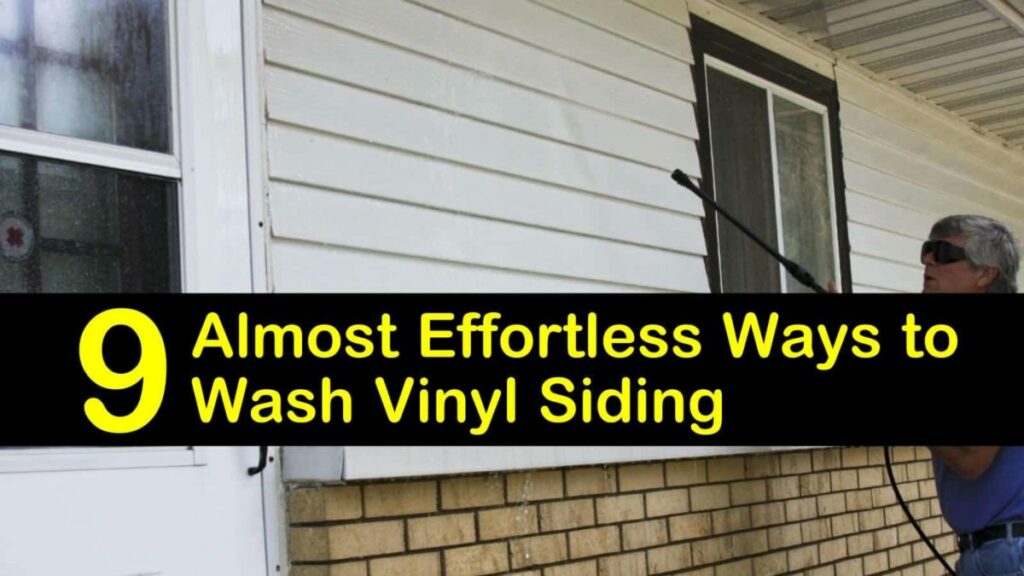The siding of a house is like the skin of an organism, protecting and containing the inner workings from outside threats. Over time, this protective shell can become stained with dirt and grime that must be removed in order to maintain a healthy and lasting surface.
Soft washing techniques for vinyl siding offer a DIY approach to keep your home looking its best without resorting to professional services or harsh chemicals. This guide will provide you with the tools and knowledge necessary to safely clean your vinyl siding in order to restore its original shine.
For those wishing for a more intensive cleaning process, soft washing provides an alternative solution that is both safe and effective. Unlike pressure washing, which can damage surfaces due to its intense force, soft washing involves the use of detergents that are gentle enough for any material while still providing excellent results.
With proper preparation and technique, anyone can learn how to properly execute soft washing techniques on their own vinyl siding with ease.
Gather Your Supplies
Preparation is key to achieving optimal results when it comes to soft washing vinyl siding; therefore, gathering the necessary supplies is essential.
When selecting detergents for soft washing, it is important to look for ones that are specifically designed for this purpose as they do not contain abrasive ingredients that could damage the surface of the siding.
A pressure washer should also be included in your list of supplies and should have a pressure rating that is suitable for the type of siding you are cleaning.
Additionally, safety equipment such as protective eyewear, gloves, and boots should be worn at all times while carrying out this task. These items will help prevent any potential harm from occurring during the cleaning process.
In addition to these basic supplies, other items may need to be purchased depending on the type of job being undertaken. For example, if access equipment such as ladders or scaffolding is required then these must be obtained prior to starting the job. This will ensure that all areas can be safely reached and cleaned without risk of injury or damage from falling objects.
Furthermore, if any specialised cleaning solutions are needed then these too should be acquired beforehand so that they are on hand when needed.
Having identified what supplies are needed and acquired them accordingly, soft washing vinyl siding can now commence with confidence knowing there will be no issues due to inadequate preparation or lack of available materials.
With clear instructions and an understanding of safety procedures in place, a successful outcome can now eagerly await completion with little worry regarding potential accidents or avoidable mistakes occurring along the way.
Prepare the Area
Before commencing the task, it is necessary to ensure that the area is ready for action. This includes protecting surrounding plants or landscaping with a tarp and hosing down the siding to get rid of any surface dirt. Once this is done, mix up your cleaning solution which can be made with warm water and a gentle detergent like dish soap.
Use an outdoor garden sprayer to apply the cleaning solution over each section of siding and let sit for 10 minutes before scrubbing off with a long-handled brush. Rinse all sections thoroughly with clean water from bottom to top and allow them to dry completely before moving on.
When applying the cleaning solution, take extra caution not to get any on nearby windows or other areas not intended for soft washing as it could cause damage. Additionally, use a ladder if needed in order to reach higher parts of vinyl siding and take appropriate safety measures when doing so such as wearing gloves, eye protection, and secure footing on the ladder at all times.
After preparing the area by protecting plants nearby and mixing up a cleaning solution using mild detergent, it’s time to begin soft washing vinyl siding. Applying the mixture onto each section of siding followed by rinsing off should do an effective job in removing dirt buildup from its exterior without causing any damage. Be sure that you rinse thoroughly from bottom to top after scrubbing off each section in order to prevent streaking or staining once dry.
Apply the Soft Washing Detergent
Using a garden sprayer, apply the cleaning solution over each section of siding to thoroughly clean and restore its original luster. It is important to take safety precautions when using a garden sprayer and applying the soft washing detergent. Wear protective goggles, long pants, gloves, and closed-toe shoes. Be sure to read the safety instructions on the product label before beginning.
Soft washing detergents come in different types such as chlorine bleach or oxygenated solutions. Chlorine bleach should be used with caution as it can cause damage if not used properly. Oxygenated solutions are gentler on vinyl siding and can provide better results without damaging it. The type of cleaning solution chosen will depend on how dirty or stained the vinyl siding is.
For best results, allow the cleaning solution time to soak into the surface before rinsing off with water from a pressure washer set at low pressure settings (1000–1500 PSI). This will help remove dirt buildup without damaging your vinyl siding while restoring its original shine and luster.
Additionally:
– Use appropriate amounts of detergent depending on how dirty your vinyl siding is
– Move around furniture that may be blocking access to some areas
– Ensure there are no plants or other vegetation near where you’re spraying
– Test a small area first for colorfastness
– Rinse off all detergent completely once finished
Rinse the Siding with a Pressure Washer
Once the cleaning solution has been applied, a pressure washer should be used to thoroughly rinse the siding. Pressure washing is an effective and efficient way of removing dirt and debris from vinyl siding while also helping to eliminate any remaining cleaning solution. To ensure soft washing safety, it is important to select a detergent that is specifically designed for use with pressure washers, as this will help reduce damage caused by high-pressure water jets.
When using a pressure washer for rinsing purposes, it is best to begin at the top of the siding and work downwards in overlapping strokes. This helps prevent streaking and can also make certain areas cleaner than others if sufficient time isn’t spent on each section. Additionally, always be sure to keep the nozzle at least eighteen inches away from the siding surface in order to avoid damaging or stripping paint off of it.
The table below provides a summary of key points related to soft washing techniques for vinyl siding:
| Point | Description | Safety Tips |
| — | — | — |
| Detergent Selection | Choose a detergent specifically designed for use with pressure washers. | Read instructions carefully before use and wear protective gear when handling chemicals.
| Operating Pressure Washer | Start at top of siding and work down in overlapping strokes; Keep nozzle at least 18 inches away from surface.| Always use caution when operating pressure washers; Be mindful of nearby windows and other surfaces that could be damaged by spray or overspray.
In summary, applying a safe detergent with a pressure washer is an important step in successfully soft washing vinyl siding surfaces without causing any damage to them. By following these simple tips, homeowners can achieve professional results without spending too much money or time on their project!
Final Clean Up and Maintenance
After pressure washing, the vinyl siding should be given a final clean-up and maintenance to ensure long-lasting beauty and protection.
The drying process is an important step in maintaining the vinyl siding. After the water is removed from the surface of the siding, it should be allowed to dry completely before applying any type of sealant or protective coating. This will help prevent any potential staining or discoloration due to moisture trapped beneath these coatings. Additionally, it will help protect against mold growth which can cause damage and deterioration to the siding over time.
In order to provide long-term protection for your vinyl siding, it should be routinely sealed with a quality acrylic latex paint sealer. This will help reduce fading from UV exposure as well as protect against dirt build up that could lead to mildew growth. Additionally, this sealer may also offer some protection against extreme weather conditions such as high winds and hail storms which can cause significant damage to unprotected vinyl siding surfaces.
It is important that regular inspections are performed in order to identify any potential issues with your vinyl siding such as cracks or other damages caused by age or wear and tear from weather elements. If these issues are found early on, they can usually be repaired without replacing entire sections of your siding, saving you both money and time in the long run while preserving its beauty and protecting your home from further damage.
Conclusion
The soft washing technique is a great way to keep vinyl siding looking fresh and clean.
It can be done safely and effectively with the right supplies and procedure.
When done correctly, it provides a deep clean that will make vinyl siding look like new again.
The results are definitely worth the effort put in.
Not only does it bring out the natural beauty of the material, but it also helps protect against mold, mildew, and other contaminants.
With proper maintenance, this method can help extend the life of your vinyl siding for years to come.
All in all, soft washing is an effective way to take care of one’s vinyl siding without risking damage or injury from harsh chemicals or pressure washers.




